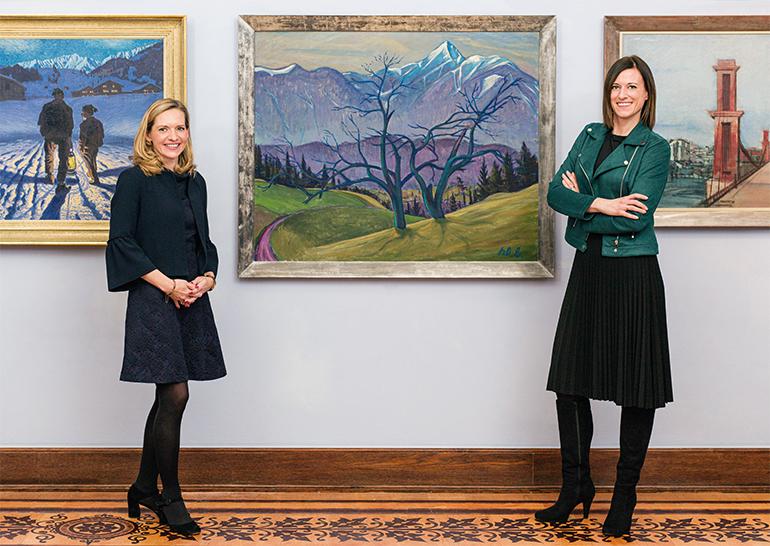In the big Christmas auction, the im Kinsky is proud to once again offer some works by the important Carinthian artist Werner Berg. The two experts Claudia Mörth-Gasser and Barbara Berger from the modern art department will give an insight into the life and work of the artist.

Which is your favourite picture?
CMG: I find the large landscape painting "Obir" particularly impressive.
The picture, which is beautifully coordinated in its colours, shows a motif that accompanied Werner Berg throughout his life: two cherry trees in front of the towering silhouette of a mountain massif, the "Obir". Firmly rooted, with branches intertwined, the pair of cherry trees stood along a path leading from the valley to Rutarhof. The painter combined the deep symbolism of these two trees with his own life situation. They appear again and again in his paintings - and with their tangled branches become an important metaphor for life situations.

BB: I am particularly impressed by the portrait "Mauki with Phlox".
The portrait from 1935, which was believed to have been lost, was purchased directly from the artist by the father-in-law of the current owner in 1936 and has been in private ownership in Germany ever since. It shows Werner Berg's wife, Amalie "Mauki" Kuster, whom the artist had already met at the beginning of his studies in Vienna in 1924 and married in 1930. Mauki, who also holds a doctorate in political science, supported Werner Berg's deep and urgent wish to become a painter throughout his life. Together with him she lived the original, rural life at Rutarhof, which was to serve as a source of inspiration for the painter's works throughout his life.

Now the Rutarhof has been mentioned more often - how can one imagine life there?
CMG: Werner Berg had bought Rutarhof in 1931. In urban society he was confronted with increasing distance and general alienation, so he withdrew and decided to lead a deliberately simple life as a farmer and painter. Far away from cultural constraints he tried to combine rural life and his artistic work. His studio was located above an old sheepfold.
The Rutarhof was a place where a very unconventional interplay of art and peasant life culture took place. It was here that pictures of a loner were created, leaving behind a singular oeuvre of high artistic rank.
Why is this oeuvre now increasingly in demand?
CMG: Pictures by Werner Berg are almost always a guarantee for nice price increases and good results at our auctions. An upward trend can be expected to continue.
On the one hand I think this reflects our zeitgeist. On the other hand, the good market development at Werner Berg is backed up by an excellent, continuous care of the work thanks to the commitment of Harald Scheicher, the grandson of the artist and administrator of the artistic estate. Last but not least, it is important that the Werner Berg Museum in Bleiburg presents changing exhibitions, where Werner Berg's artistic work is also placed in an international context.
Speaking of international: A Finnish motif can be found in the painting "Late Summer". How can that be explained?
BB: Werner Berg was sent to Scandinavia, Finland and Norway in 1942 as a "war painter". Until 1945 he recorded his impressions of foreign landscapes and people in about one hundred works, mainly on paper. Only in late autumn 1945 Werner Berg was able to return to Rutarhof. These works, created during the war years, with their realistic, documentary depiction of the landscape, are to be regarded as a separate group of works - to which the museum has already dedicated a separate exhibition.
About the painting "Snow Roses" - aren't flower pictures rather untypical for Werner Berg?
BB: Not at all! In recent years, the painter has not only been represented on the auction market with his landscapes and figure paintings, but also repeatedly with his flower depictions. As Harald Scheicher comments on the painting "Snow Roses", this is not simply a motif from the familiar surroundings of the Rutarhof - the blooming roses are also to be understood as a sign of a new beginning. Berg's work was shown in 1935 in the course of the travelling exhibition "Degenerate Art" and was partly destroyed. Withdrawn to his farm, the painter processed what he had experienced and tried to gain confidence in a new beginning.
